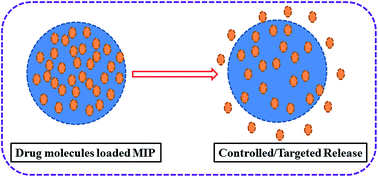Latest trends in molecular imprinted polymer based drug delivery systems
Abstract
Molecular imprinted polymers (MIP) are promising and versatile materials that have been used for the determination of many different analytes. In the last few years, MIPs have been substantially employed for various biomedical applications, especially drug delivery systems (DDS), owing to some of their unique features such as specific recognition by imprinting the desired analyte, suitability in rough experimental conditions, and targeted and sustained drug release. Hence, this review is focused on the development of strategies undertaken for their application to drug delivery systems involving several different administration routes (i.e. transdermal, ocular and oral routes) published between 2014 and now. Herein, we have also highlighted the summaries of published works, in order to gain a better understanding of the synthetic strategies employed and the analytical performances of the reported MIPs, in addition to pointing out the challenges and future perspectives of MIP based DDS.


 Please wait while we load your content...
Please wait while we load your content...